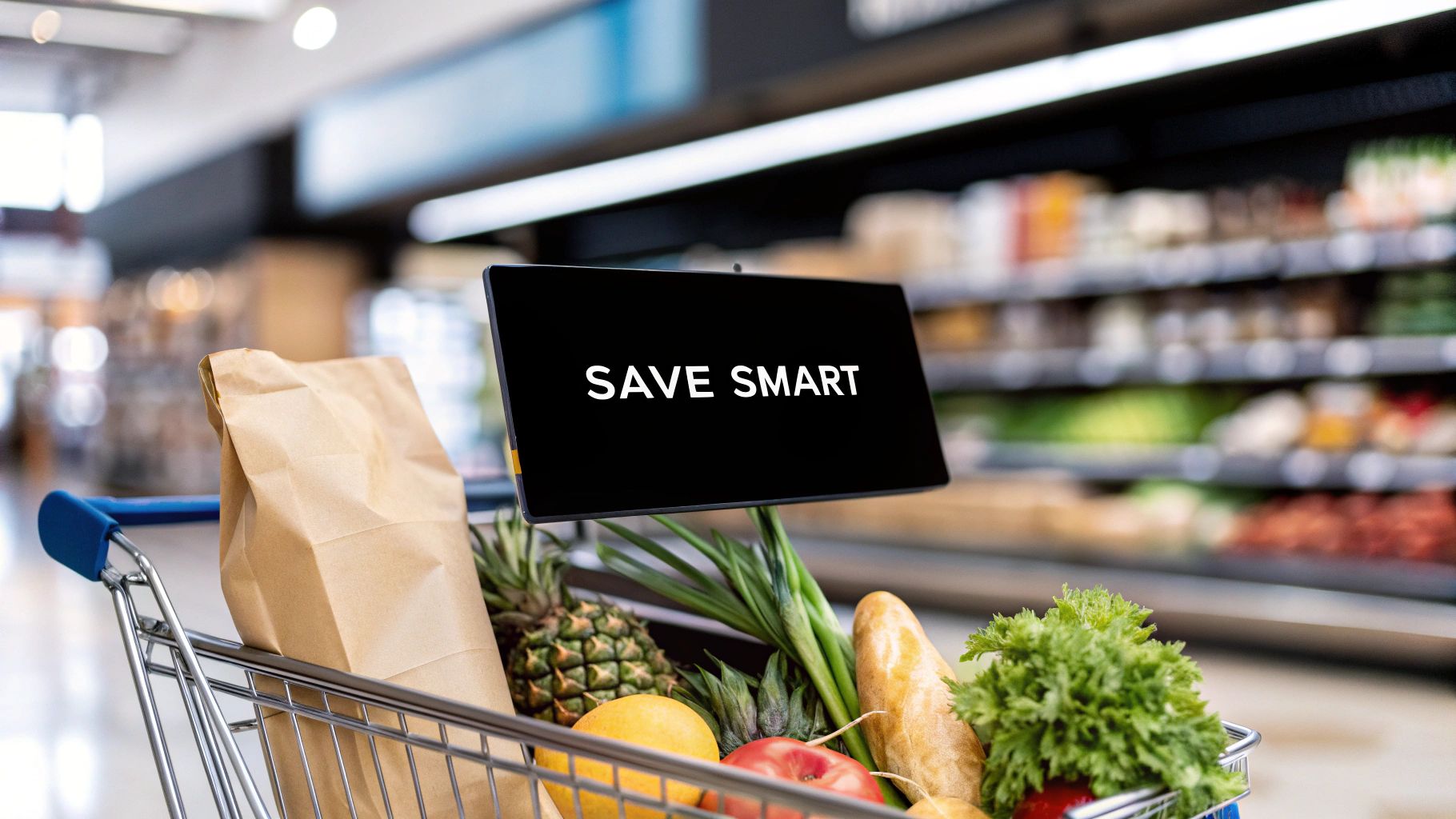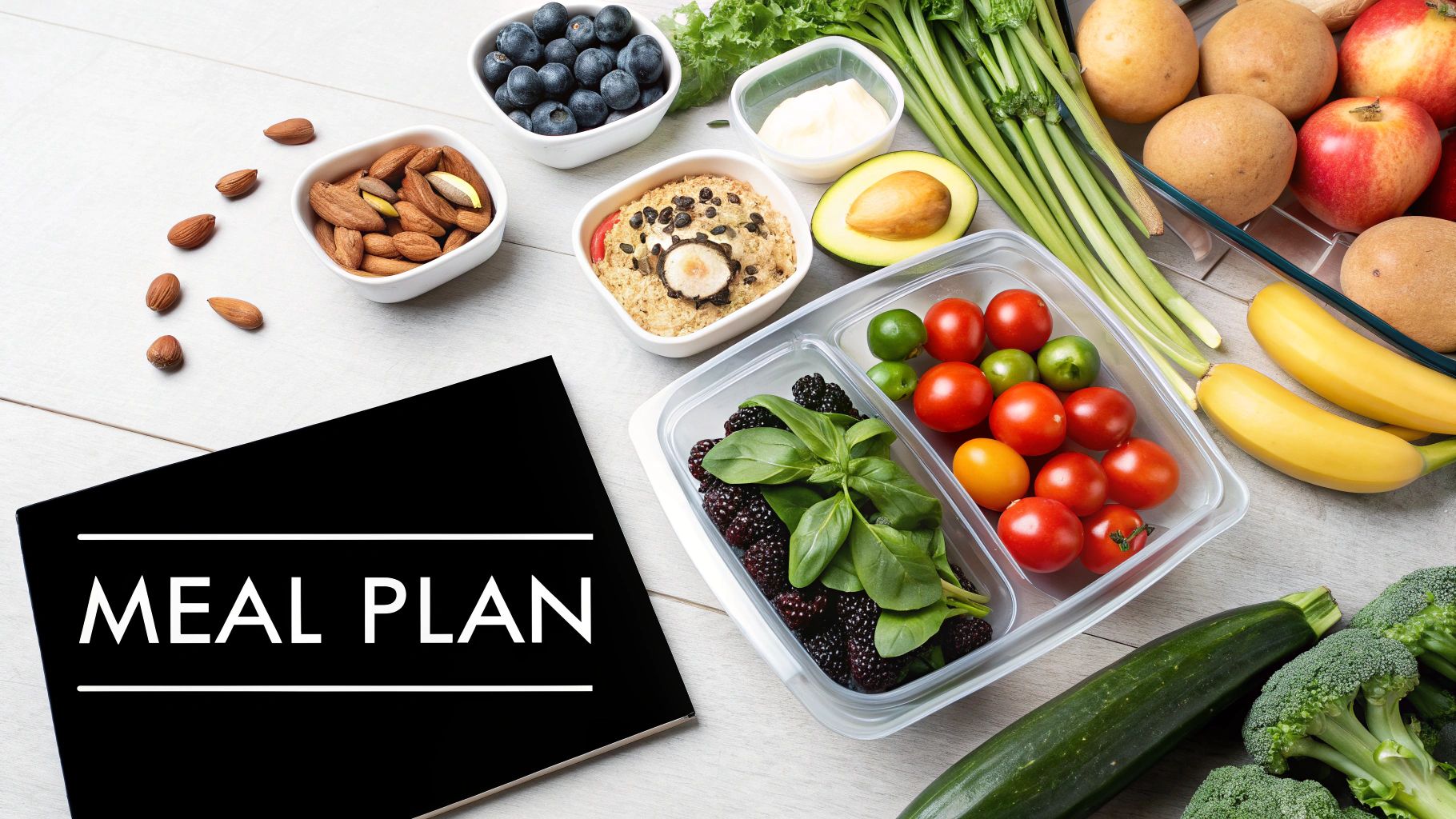
The Real Cost of Feeding Your Family Today

Grocery shopping can feel like a never-ending struggle to keep up with rising prices. Understanding what's behind these increases is the first step to creating a budget that works. This isn't about general tips; it's about giving you the information you need to develop a personalized plan for your family.
Decoding the Drivers of Rising Food Costs
Several interconnected factors contribute to climbing grocery costs. Inflation plays a significant role, affecting the price of everything from the ingredients themselves to the cost of getting them to your store. For example, higher fuel costs impact the whole supply chain, increasing the expenses associated with transporting food from the farm to your table. Global events, such as supply chain disruptions and geopolitical instability, also contribute to scarcity and price hikes.
Beyond Inflation: The Premiumization Effect
Inflation isn't the only factor. Consumers are increasingly choosing premium products, which drives demand—and prices—up. This trend toward higher-quality ingredients, convenient pre-made meals, and specialty items adds significantly to rising grocery bills. This means that even if overall inflation drops, your grocery bill might continue to increase if you purchase more premium items.
In fact, the global average household grocery spending topped $1,000 annually for the first time in 2023, fueled by persistent inflation and this shift toward premium products. Kantar's analysis of 62 markets revealed a nearly 60% increase compared to 2013, with North American households spending the most at $3,063 annually. You can find more detailed statistics here. This underscores the need for smarter budgeting strategies, not just overall spending cuts. You might also be interested in our sitemap for other helpful articles.
Regional Variations and Category-Specific Inflation
The impact of these economic forces isn't felt equally everywhere. Regional price variations, influenced by local supply and demand, can significantly impact what you spend. Similarly, category-specific inflation, where some food groups see much sharper price increases than others, requires a more nuanced approach to budgeting. Understanding these variations is key to tailoring your grocery list and finding affordable alternatives. This emphasizes the importance of developing a grocery budget that truly reflects your unique situation.
Creating a Grocery Budget That Actually Works

Now that we understand what influences grocery prices, let's talk about creating a personalized grocery budget. Forget generic advice; a successful budget should reflect your unique needs and financial situation. This means understanding how you spend and making smart choices without feeling restricted.
Assessing Your Current Grocery Spending
Knowing where your money currently goes is the foundation of any good budget. Start by tracking your grocery expenses for a month. This gives you valuable insight into your spending patterns and highlights potential areas to save. You might discover, for example, that you're overspending on snacks or pre-made meals. This awareness is the first step toward positive change.
Building a Flexible Framework
Effective grocery budgets aren't rigid. They balance structure with flexibility. Set a monthly grocery allowance, but allow for seasonal price changes and special occasions. Also, consider your household size. A single person's needs and spending will differ from a family of four. Factor in dietary needs, preferences, and how often you cook. Your food values are just as important as your financial goals. Food spending as a percentage of total consumer expenditure can vary considerably. Low-income countries often allocate over 30% of their budgets to food, versus under 15% in wealthier nations. Learn more about this at the World Bank.
Practical Tracking Methods
Tracking your spending doesn't have to be a chore. Use budgeting apps like Mint, spreadsheets, or even a simple notebook. The key is to find a system you can maintain. Once you understand the real cost of your grocery habits, consider cheap meal prep. Planning your meals in advance helps minimize impulse buys and reduces food waste.
Setting Realistic Benchmarks and Measuring Progress
Set achievable goals to track your progress. Don't try to cut your spending drastically overnight. Instead, make small, incremental changes. Reducing your spending by 5-10% each month is more sustainable than aiming for a 50% reduction immediately. This approach helps build lasting habits without feeling overwhelmed. Remember, grocery budgeting is about finding a balance that works for you and your family.
To help you further, let's look at recommended grocery budget percentages based on income and household size:
Recommended Grocery Budget Percentages by Income Level
This table provides guidelines for what percentage of your monthly income should be allocated to groceries based on different income brackets and household sizes. It’s important to remember these are just guidelines and your actual needs may vary.
| Income Level | Single Person | Family of 2-3 | Family of 4+ |
|---|---|---|---|
| Low | 15-20% | 20-25% | 25-30% |
| Medium | 12-15% | 15-20% | 20-25% |
| High | 8-10% | 10-12% | 12-15% |
As you can see, the recommended percentage of income spent on groceries decreases as income increases. Larger families also typically need to allocate a greater percentage of their income to food. Use this table as a starting point and adjust based on your individual circumstances.
The Meal Planning Revolution Your Wallet Needs

Creating a practical grocery budget is an essential first step. But to truly optimize your spending, you need meal planning. This isn't simply about deciding what’s for dinner each night. It's a strategic approach that can transform your budget and your entire mealtime experience, leading to less stress, less waste, and more enjoyment of your food.
Minimizing Waste, Maximizing Satisfaction
Effective meal planning helps you avoid impulse buys and significantly reduces food waste. By purchasing only what you need for your planned meals, you'll minimize those end-of-the-week refrigerator cleanouts. This translates directly into savings and a more sustainable approach to grocery shopping. Plus, planning ensures efficient ingredient use. Leftover roasted chicken, for instance, can easily become chicken salad sandwiches for lunch the following day.
Personalized Planning: Making It Work for You
The ideal meal planning system is one tailored to your lifestyle. Consider your schedule, food preferences, and cooking skills. Are you a busy professional with limited time? Focus on quick and easy recipes. Do you have picky eaters? Involve them in the planning process to increase their acceptance of the meals. The goal is to create a system that’s practical and enjoyable, not another chore on your list. Learn more in our article about how to master meal planning and budgeting for groceries.
Creative Approaches: Ingredient Cross-Utilization and Batch Cooking
Elevate your meal planning with strategies like ingredient cross-utilization. This involves using the same ingredients in multiple meals throughout the week. For example, a large bag of spinach can be used in salads, smoothies, and as a side dish, saving you money and reducing planning time.
Batch cooking is another valuable strategy, especially for busy individuals and families. Prepare large quantities of staples like rice, beans, or roasted vegetables on the weekend and use them as the foundation for quick weeknight meals. This frees up your time during the week so you can enjoy delicious, home-cooked meals without the hassle.
Navigating Unexpected Challenges
Life throws curveballs. Even the best-laid meal plans can be disrupted by unexpected events. Build flexibility into your system. Keep a few pantry staples on hand for those nights when cooking just isn't feasible. Frozen vegetables, canned beans, and pasta can be combined into quick, nutritious meals. Don't be afraid to adjust your plan as needed. Maintaining a consistent planning habit, even when things don’t go perfectly, is key. This builds resilience and ensures that grocery budgeting remains a sustainable practice.
Shopping Psychology: Outsmart the Grocery Game

Grocery stores are strategically designed to encourage you to spend more. Understanding these tactics helps you regain control of your budget and make smart decisions. This means recognizing store influences and developing counter-strategies. Let's explore how to outsmart the grocery game.
Decoding Retail Tactics: How Stores Influence Your Spending
Supermarkets use several psychological tricks to entice shoppers. Product placement is a major one. Essential items, like milk and eggs, are often at the back, forcing you to walk past tempting displays. End-cap displays, positioned at the end of aisles, are designed to catch your eye and encourage impulse buys. Even the music and lighting contribute to an atmosphere designed to loosen your wallet.
The following table helps to summarize and compare the pros and cons of various grocery shopping methods:
Comparison of Grocery Shopping Methods
| Shopping Method | Average Price Premium | Time Investment | Impulse Purchase Risk | Best For |
|---|---|---|---|---|
| In-Store | None | Moderate | High | Individuals who prefer to select their own produce, and those looking for deals. |
| Online Delivery | Can vary, often higher | Low (shopping) High (delivery window) | Low | Convenience-focused shoppers and individuals with limited mobility. |
| Pickup Services | Can vary, often slightly higher | Low | Medium | Shoppers who want to avoid delivery fees and minimize in-store time. |
This table highlights the trade-offs between cost, convenience, and impulse control for each shopping method. Understanding these dynamics empowers you to choose the best approach for your needs and budget.
Timing Is Everything: Strategic Shopping Patterns
When you shop matters. Shopping while hungry or tired often leads to more impulse purchases. Weekday evenings and weekends tend to be crowded, adding stress and making it harder to stick to your list.
Shopping during less busy times, like weekday mornings, allows for more focused, budget-conscious shopping. This reduces distractions and keeps you on track.
Evaluating Deals: Beyond The Flashy Signage
Not every "deal" is a bargain. "Buy one, get one free" (BOGO) offers can be tempting, but do you really need two? Bulk purchases can save money, but only if you use the product before it expires.
Learn to compare unit prices to see the true cost per ounce or pound. This helps you determine if a deal is truly a bargain. You'll be making rational decisions based on value, not just marketing.
Loyalty Programs and Price Comparison Tools: Maximizing Your Savings
Loyalty programs can offer personalized discounts and exclusive deals. Price comparison apps let you track prices across different stores to find the best offers. These tools provide valuable insights into maximizing savings.
Be mindful of how programs might influence your choices. A loyalty program might steer you to a specific store, even if it doesn't always have the best overall prices. Strategic use of these tools is key for effective grocery budgeting.
The Premium vs. Value Equation: Strategic Splurges
Sometimes, premium products are worth the extra money. Consider your food values. If organic produce or high-quality meat are important to you, budget accordingly.
Don't assume a higher price always means better quality. Compare ingredients and nutritional information. This helps you balance your desire for quality with your budget. China's online grocery spending reached $147 billion in Q3 2023, highlighting a global shift towards digital food budgeting here. This underscores how technology is impacting our shopping habits.
Eating Well Without Breaking the Bank
Eating nutritious food doesn't have to mean emptying your wallet. This section explores practical ways to balance healthy eating habits with a realistic grocery budget. We'll look at smart strategies that prioritize both your health and your finances, without sacrificing flavor or feeling satisfied.
Nutrient-Dense Foods: Getting the Most for Your Money
One of the keys to smart grocery shopping is focusing on nutrient-dense foods. These foods offer a high concentration of vitamins and minerals for a relatively low cost. Excellent examples include beans, lentils, eggs, and frozen fruits and vegetables. Frozen berries, for instance, are often less expensive than fresh berries, yet offer similar nutritional value.
The Cost-Per-Nutrient Ratio: Making Informed Choices
Thinking about the cost-per-nutrient ratio can help you make informed decisions at the grocery store. This involves considering the amount of a particular nutrient you receive for every dollar you spend. While some premium health foods might seem pricey at first glance, they can actually offer excellent value when you factor in their nutrient density.
Conventional vs. Organic: Finding the Right Balance
Choosing between conventional and organic produce can be a dilemma. While organic foods are often seen as the healthier choice, they typically come with a higher price tag. One approach is to prioritize buying organic for items known to have higher pesticide residues, such as strawberries and spinach. For other fruits and vegetables, conventional options might provide ample nutrition at a more affordable price. This strategy allows you to align your spending with your budget and health goals.
Strategic Trade-Offs: Protecting Your Health and Your Wallet
Smart budgeting often involves strategic trade-offs. This doesn't mean sacrificing your health, but rather making intelligent choices that maximize value. For example, opting for less expensive cuts of meat and preparing them in flavorful recipes can significantly reduce your grocery bill without impacting your protein intake. You might also find helpful resources on budgeting on our product sitemap. Similarly, buying in bulk for staples you use regularly can lead to substantial savings. This frees up your budget to prioritize more expensive, nutrient-dense items when necessary. Successfully balancing your health and financial goals involves thoughtful decisions that support your overall well-being.
Building Sustainable Food Budget Habits That Last
Saving money on groceries isn't a one-time accomplishment; it's about establishing sustainable habits. Like any lifestyle change, grocery budgeting requires consistent effort and adaptation. This means crafting strategies that not only save money but also seamlessly integrate into your life, even during busy periods. Let's explore how to create lasting changes in your food spending habits.
Engaging the Whole Family: Teamwork Makes the Dream Work
For long-term success, family involvement is essential. Initiate open discussions about your budgeting goals and the rationale behind them. Including everyone in meal planning and grocery list creation can foster buy-in and minimize resistance. Assigning specific meal planning responsibilities to different family members, for example, can make the process more engaging and collaborative.
Maintaining Momentum: Staying on Track During Busy Periods
Life gets busy, making it easy to neglect good habits. An effective strategy is scheduling dedicated time for meal planning and grocery shopping, similar to any other important appointment. Batch cooking can also help you stay on track during hectic weeks, ensuring that healthy, budget-friendly meals are readily available, even when time is short.
Adapting to Change: Life Happens, Budgets Adjust
Life is full of unexpected events – job changes, unforeseen expenses, growing families. Your grocery budget should be flexible enough to accommodate these changes. Regularly reassess your spending and adjust your budget as needed. This might involve discovering new ways to save or reallocating funds within your overall budget. This proactive approach ensures your grocery budget stays relevant and effective, regardless of life's inevitable changes.
Overcoming Common Obstacles: Real-World Solutions
Even with the best intentions, challenges will arise. Social pressure to dine out or purchase expensive ingredients can disrupt your budget. Food fatigue can lead to impulsive buying and overspending. Addressing these obstacles directly is crucial for sustainable change. For tips on budgeting in other areas, check out this article: Home Decor On A Budget. Sometimes, seemingly unrelated budgeting practices can provide valuable insights.
Measuring Progress and Celebrating Wins: Beyond the Dollar Amount
Tracking your progress is vital, but don't solely focus on the money saved. Acknowledge non-monetary wins, such as reduced food waste, more frequent family meals, or improved cooking skills. Celebrating these accomplishments reinforces positive behaviors and helps maintain motivation. Acknowledging a week of successful meal planning with a fun family activity, for instance, can be a powerful motivator.
Personalized Systems: Balancing Structure and Flexibility
Develop a system that works for you. This might involve a detailed weekly meal plan, a flexible framework with rotating recipes, or a combination of both. The key is finding a balance between structure and flexibility that you can maintain long-term. Your grocery budget should be adaptable to your evolving needs and preferences. This ensures that your system remains a helpful tool, not a source of stress.
Building sustainable food budget habits is an ongoing journey. By embracing flexibility, involving your family, and celebrating your progress, you can create lasting changes that benefit both your finances and your overall well-being.
Find the perfect products for your planned meals and stick to your grocery budget with ease! Explore FindTopTrends for a wide selection of high-quality products at competitive prices.





